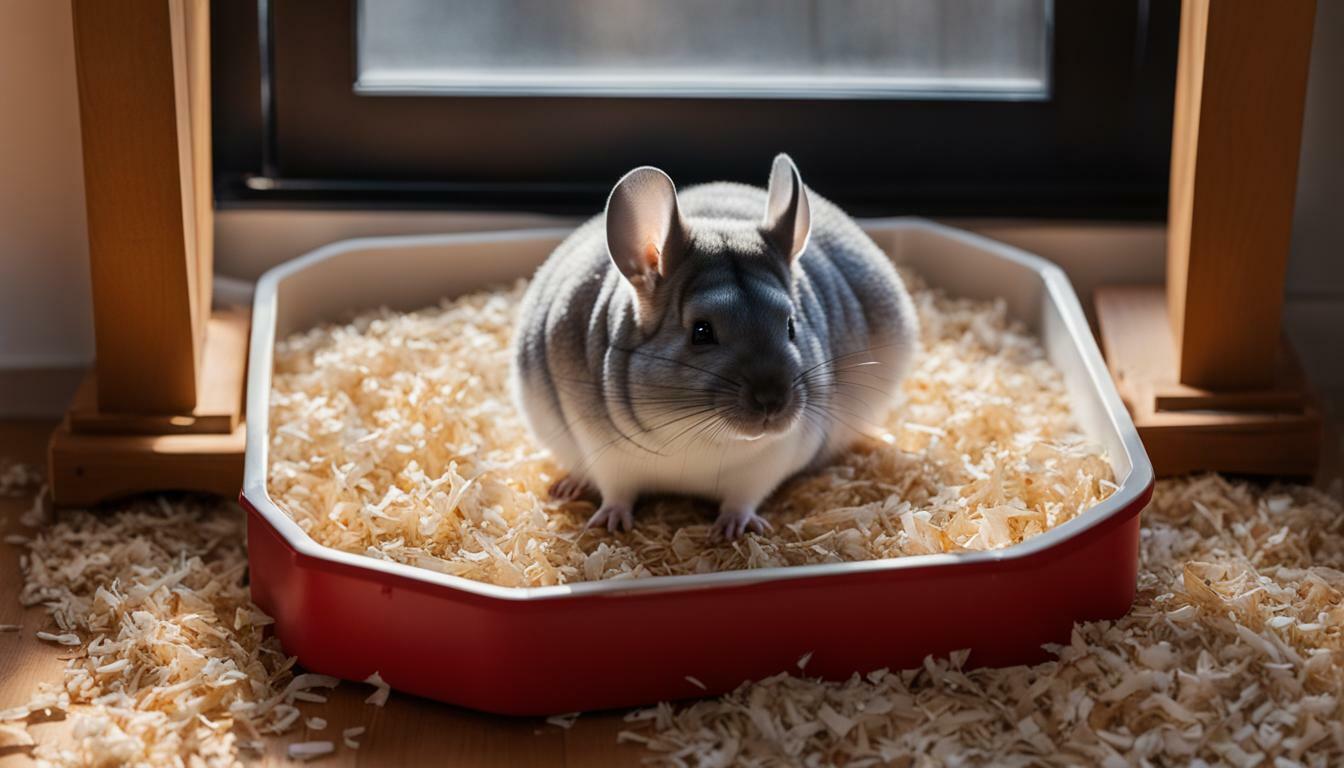Chinchillas are intelligent animals that can be trained to use a litter box for urination. While they may not be able to be trained for defecation, litter training can help maintain cleanliness and hygiene in their living environment. Starting the training process when they are young is recommended, as their habits can be influenced at an early age. Observing their bathroom habits and placing the litter box in the area they typically use can encourage them to use it. Using soiled bedding in the litter box can help them recognize it as their designated bathroom area. Training during their most active hours, which are typically at dusk and dawn, can lead to more successful outcomes. Using the right treats as rewards and providing a chinchilla-safe litter are important factors in the training process. Regular cleaning of the litter box is necessary, and DIY litter boxes can be made using options like Pyrex glass baking dishes or ceramic dishes. With consistent training and proper maintenance, chinchillas can adapt to using a litter box for urination.
Key Takeaways:
- Chinchillas can be trained to use a litter box for urination.
- Start training them when they are young for better results.
- Observe their bathroom habits and place the litter box in their preferred area.
- Use soiled bedding in the litter box to help them recognize it as their designated bathroom area.
- Train them during their most active hours, which are typically at dusk and dawn.
Starting Litter Training at a Young Age
To increase the likelihood of successful litter training, it is recommended to start training your chinchilla when they are young. By introducing them to the concept of a litter box at an early age, you can help establish good habits that will benefit both you and your furry friend in the long run.
When starting litter training, it is important to observe your chinchilla’s behavior. Notice where they typically urinate and defecate, as this will help you choose the optimal location for the litter box. Placing it in the area they already prefer can increase the chances of them using it.
One helpful tip is to use soiled bedding from your chinchilla’s cage in the litter box. This will help them recognize the scent and associate the litter box with their bathroom area. Simply place the soiled bedding in the litter box and let your chinchilla explore and become familiar with it.
| Key Tip: | Training during your chinchilla’s active hours, typically at dusk and dawn, can be more effective as they are naturally more inclined to use the litter box during these periods. |
|---|
When it comes to rewards, choose treats that your chinchilla loves and use them as positive reinforcement during the training process. This will help motivate them to use the litter box and reinforce the desired behavior.
Lastly, make sure to use litter that is safe for chinchillas. Avoid regular cat litter, paper, or store-bought litters, as they may contain ingredients that can be harmful to your furry friend. Opt for kiln-dried pine or a dust-free, fragrance-free litter designed specifically for small animals.
Observing Chinchilla Bathroom Habits
Understanding your chinchilla’s bathroom habits is crucial for effective litter training. While chinchillas can be trained to use a litter box for urination, they do not have the same level of control when it comes to defecation. By observing their natural behaviors, you can create an environment that encourages proper bathroom habits and makes litter training easier.
Chinchillas tend to have specific areas where they prefer to urinate and defecate. These areas are often marked by a noticeable accumulation of droppings or a particular scent. By placing the litter box in the designated area, you can increase the likelihood that your chinchilla will use it. It’s important to note that chinchillas may have multiple bathroom spots, so observing their habits will help you identify these areas and determine the best placement for the litter box.
| Tip: | Use a non-absorbent lining, such as a tray or shallow container, for the litter box. Chinchillas have a tendency to chew on bedding, so using something that is safe and resistant to chewing is essential for their health. |
|---|
In addition to identifying the location for the litter box, you can also use soiled bedding as a training aid. Chinchillas have a strong sense of smell, and placing soiled bedding in the litter box will help them recognize it as their designated bathroom area. This can be especially helpful if your chinchilla is resistant to using the litter box initially.
By understanding and observing your chinchilla’s bathroom habits, you can establish a successful litter training routine. Remember to be patient and consistent with the training process, providing positive reinforcement when your chinchilla uses the litter box correctly. With time and effort, your chinchilla can become litter trained, making both their hygiene and your cleaning routine much easier to manage.
Placing the Litter Box in the Right Spot
The proper placement of the litter box plays a key role in encouraging your chinchilla to use it for urination. By placing the litter box in the area where your chinchilla typically goes to relieve itself, you are providing them with easy access and a familiar spot for their bathroom needs.
Observe your chinchilla’s bathroom habits and identify the area they consistently use for urination. This can be a corner of their cage or a specific spot they prefer. Once you have determined the location, place the litter box there to encourage them to use it.
It is important to note that chinchillas have a natural inclination to urinate in elevated areas. Therefore, consider elevating the litter box slightly using a sturdy platform or shelf. This will mimic their natural behavior and make the litter box more appealing to use.
| Tip: | Elevate the litter box slightly to mimic your chinchilla’s natural bathroom habits. |
|---|
Another factor to consider is the size of the litter box. Ensure that it is spacious enough for your chinchilla to comfortably enter and turn around. A litter box that is too small may discourage them from using it and lead to accidents outside the designated area.
By placing the litter box in the right spot, you are setting your chinchilla up for success in their litter training journey. Remember to observe their bathroom habits, choose an elevated location, and provide a spacious litter box to create an inviting and efficient bathroom area for your furry friend.
Using Soiled Bedding as a Training Aid
Soiled bedding can be a valuable training aid when teaching your chinchilla to use a litter box. Chinchillas have a natural tendency to mark their territory by urinating on certain surfaces. By placing soiled bedding in the litter box, you can help them recognize it as their designated bathroom area.
Start by placing a small amount of soiled bedding in the litter box. This could be bedding that has been used in their cage or an area where they have previously urinated. The scent of their urine on the bedding will help attract them to the litter box and encourage them to use it.
It is important to note that chinchillas do not typically use a litter box for defecation. They tend to scatter their droppings throughout their cage. However, by providing a separate area for urination, you can minimize the mess and keep their cage cleaner.
| Tip: | Consider using a shallow pan or tray for the litter box, as it is easier for your chinchilla to access. Pyrex glass baking dishes or ceramic dishes can be used as DIY litter boxes. |
|---|---|
| Important: | Avoid using regular cat litter, paper, or store-bought litters, as these can be harmful to chinchillas. Instead, opt for chinchilla-safe litter, such as kiln-dried pine or a dust-free, fragrance-free litter designed specifically for small animals. |
When introducing the litter box with soiled bedding, it is essential to keep a close eye on your chinchilla’s behavior. Observe if they show interest in the litter box or if they continue to urinate in their usual spot. If they consistently use the litter box, gradually increase the amount of bedding in the box to reinforce the behavior.
Expert Tip:
“Using soiled bedding as a training aid is a gentle and effective way to teach your chinchilla to use a litter box. Remember to be patient and consistent, as each chinchilla may have different preferences and learning speeds. With time and positive reinforcement, your chinchilla will develop good litter box habits.”
By utilizing soiled bedding, you can assist your chinchilla in recognizing the litter box as their designated bathroom area. Combined with other training techniques, such as proper placement of the litter box and consistent rewards, you can successfully train your chinchilla to use a litter box for urination, promoting cleanliness and hygiene in their cage.
| In Summary: |
|---|
| – Soiled bedding can be a useful training aid to help chinchillas recognize the litter box as their designated bathroom area. |
| – Introduce small amounts of soiled bedding in the litter box to attract your chinchilla and encourage them to use it for urination. |
| – Chinchillas typically do not use a litter box for defecation, so it’s important to provide a separate area for urination. |
| – Use chinchilla-safe litter, such as kiln-dried pine or a dust-free, fragrance-free litter, and avoid regular cat litter, paper, or store-bought litters. |
| – Observe your chinchilla’s behavior and gradually increase the amount of bedding in the litter box as they consistently use it. |
Training During Active Hours
Training your chinchilla to use a litter box during their active hours can yield better results. Chinchillas are most active at dusk and dawn, which makes these optimal times for training. By aligning their training sessions with their natural activity patterns, you can increase the chances of success.
During these active hours, chinchillas are more likely to engage in their natural behaviors, which includes using the bathroom. By observing their bathroom habits during this time, you can identify the area they typically choose for urination and defecation. This information is vital for effectively placing the litter box in the right spot.
When training your chinchilla, it’s important to provide positive reinforcement. Using the right treats as rewards can motivate them to use the litter box consistently. Choose treats that are safe for chinchillas and that they find enticing. By offering these treats immediately after your chinchilla uses the litter box correctly, you can reinforce the desired behavior and encourage them to continue using it.
To ensure a successful training process, use chinchilla-safe litter in the litter box. Kiln-dried pine or a dust-free, fragrance-free litter designed for small animals are suitable options. Avoid using regular cat litter, paper, or store-bought litters, as these may be harmful to your chinchilla’s health.
| Do: | Don’t: |
|---|---|
| Start training your chinchilla when they are young. | Force your chinchilla to use the litter box for defecation. |
| Observe their bathroom habits to determine the area they prefer. | Use regular cat litter, paper, or store-bought litters in the litter box. |
| Place the litter box in the area they typically use for urination. | Neglect regular cleaning and maintenance of the litter box. |
| Use soiled bedding in the litter box to help them recognize it as their designated bathroom area. | Train your chinchilla to use the litter box during their inactive hours. |
| Train your chinchilla during their most active hours, which are at dusk and dawn. | Use treats that are not suitable or safe for chinchillas. |
By following these tips and being patient and consistent in your training efforts, you can successfully teach your chinchilla to use a litter box for urination. Remember, every chinchilla is unique, so the training process may vary from one individual to another. Stay attuned to your chinchilla’s needs and behaviors, and adjust the training approach accordingly. With time and persistence, you’ll have a litter-trained chinchilla that enjoys an enhanced level of hygiene, benefiting both you and your furry friend.
Choosing the Right Rewards
Selecting the appropriate rewards is essential when training your chinchilla to use a litter box. By offering enticing treats as positive reinforcement, you can encourage your furry friend to develop good bathroom habits. When choosing rewards for your chinchilla, opt for small, chinchilla-friendly treats that are healthy and safe for their consumption.
Table 1: Recommended Treats for Litter Training
| Treat | Description |
|---|---|
| Timothy Hay Pellets | These tasty pellets provide essential nutrients and are an excellent choice for rewarding your chinchilla during litter training. |
| Dried Apple Slices | Chinchillas love the sweet taste and chewy texture of dried apple slices. These treats can be a great incentive for using the litter box consistently. |
| Rose Hips | Rich in vitamins and antioxidants, rose hips make a healthy and enticing reward for your chinchilla. These small fruits can be given as a special treat during litter training sessions. |
In addition to treats, chinchillas may also respond well to verbal praise and gentle petting as rewards. Positive reinforcement, coupled with consistency and patience, can help your chinchilla understand and embrace the litter box as their designated bathroom area.
Remember:
- Use small, chinchilla-friendly treats as rewards
- Choose healthy options like timothy hay pellets, dried apple slices, and rose hips
- Offer verbal praise and gentle petting along with treats
- Be consistent and patient throughout the litter training process
By selecting the right rewards and providing positive reinforcement, you can effectively train your chinchilla to use a litter box for urination. Remember, however, that chinchillas naturally tend to defecate in multiple locations within their enclosure. It is important to regularly clean their living space to maintain hygiene and minimize odors.
Selecting Chinchilla-Safe Litter
Choosing the right type of litter is crucial for maintaining your chinchilla’s hygiene and overall well-being. Some litters may contain harmful substances or create dust that can irritate your pet’s sensitive respiratory system. When it comes to selecting litter for your chinchilla’s litter box, it’s important to opt for safe and suitable options.
One popular choice is kiln-dried pine pellets, which are affordable and readily available. These pellets are highly absorbent, reducing odors and keeping the litter box clean. Additionally, they have natural properties that can help control bacteria and eliminate moisture, promoting a healthier environment for your chinchilla.
Another option is a dust-free, fragrance-free litter specifically designed for small animals like chinchillas. These litters are often made from materials such as recycled paper or plant fibers, providing a safe and comfortable substrate for your pet. The dust-free nature of these litters ensures that your chinchilla won’t inhale any harmful particles that could lead to respiratory issues.
| Litter Type | Pros | Cons |
|---|---|---|
| Kiln-dried pine pellets | Highly absorbent, reduces odors, controls bacteria | May be less comfortable than other options |
| Dust-free, fragrance-free litter | Safe, comfortable, dust-free, respiratory-friendly | May be more expensive |
It’s important to note that you should avoid using regular cat litter, as it can be harmful to chinchillas when ingested or inhaled. Additionally, paper or store-bought litters may contain additives or fragrances that could irritate your pet. Always check the label and choose a litter that is specifically formulated for chinchillas or small animals.
In summary, selecting the right type of litter for your chinchilla is essential for their hygiene and well-being. Kiln-dried pine pellets and dust-free, fragrance-free litters designed for small animals are the best options to ensure a clean and safe environment for your furry friend. By providing the appropriate litter, you can create a comfortable space for your chinchilla to do their business, promoting good bathroom habits and maintaining their overall health.
Regular Cleaning and Maintenance
Regular cleaning and maintenance of the litter box are essential for a hygienic environment for your chinchilla. Chinchillas are known for their cleanliness, and maintaining a clean litter box helps prevent odors and keeps your pet healthy. Here are some tips to ensure proper cleaning and maintenance of your chinchilla’s litter box.
1. Frequency of Cleaning
It is important to clean the litter box regularly to maintain cleanliness. Scoop out any soiled bedding or waste daily to prevent odor buildup. Depending on the size of the box and the number of chinchillas using it, a full cleaning of the litter box should be done at least once a week. Remove all the bedding, wash the box with mild soap and water, and dry it thoroughly before refilling with fresh bedding.
2. Choosing the Right Bedding
Selecting the appropriate bedding is crucial for maintaining hygiene in the litter box. Avoid using regular cat litter, paper, or store-bought litters, as they may contain harmful ingredients or produce excessive dust. Opt for chinchilla-safe bedding options like kiln-dried pine or dust-free, fragrance-free litters specifically designed for small animals. These types of bedding will help absorb moisture and control odor effectively.
3. DIY Litter Box Options
If you prefer a DIY approach, you can create your own litter box using Pyrex glass baking dishes or ceramic dishes. These materials are easy to clean, and their smooth surfaces make it difficult for bacteria and odors to accumulate. Ensure the dish is deep enough to hold an adequate amount of bedding, and place it in a location that is easily accessible to your chinchilla.
| Tip | Table |
|---|---|
| Remember to wash your hands thoroughly after cleaning the litter box to prevent the spread of germs. | Use a litter scoop with small holes to effectively remove waste from the bedding. |
In summary, regular cleaning and maintenance of the litter box are crucial for maintaining a hygienic environment for your chinchilla. Clean the litter box frequently, choose the right chinchilla-safe bedding, and consider DIY litter box options if desired. By following these tips, you can ensure your chinchilla has a clean and comfortable bathroom area while promoting their overall health and well-being.
Conclusion
Litter training can be a beneficial practice for chinchilla owners, promoting cleanliness and hygiene for both the chinchilla and its living environment. While chinchillas can be trained to use a litter box for urination, it is important to note that they may not be able to be trained for defecation. However, by starting the training process at a young age, observing their bathroom habits, and placing the litter box in the appropriate spot, you can significantly increase the chances of success.
To help your chinchilla recognize the litter box as their designated bathroom area, you can incorporate soiled bedding into the litter box. This will provide a familiar scent and encourage them to use the box consistently. Training during their most active hours, which are typically at dusk and dawn, can also be advantageous for successful litter training.
Choosing the right rewards, such as chinchilla-safe treats, can further motivate your chinchilla to use the litter box. It is crucial to use litter that is safe for chinchillas, such as kiln-dried pine or a dust-free, fragrance-free litter specifically designed for small animals. Regular cleaning and maintenance of the litter box is essential to ensure hygienic conditions for your chinchilla and to encourage continued litter box usage.
If you prefer a DIY approach, you can make litter boxes using options like Pyrex glass baking dishes or ceramic dishes. These alternatives can provide a suitable and convenient option for litter training your chinchilla.
FAQ
Can chinchillas be trained to use a litter box?
Yes, chinchillas can be trained to use a litter box for urination, but not for defecation.
When should I start litter training my chinchilla?
It is recommended to start litter training chinchillas when they are young.
How can I encourage my chinchilla to use the litter box?
You can encourage your chinchilla to use the litter box by observing their bathroom habits and placing the litter box in the area they typically use.
Can I use soiled bedding to help train my chinchilla?
Yes, placing soiled bedding in the litter box can help your chinchilla recognize it as the designated bathroom area.
When is the best time to train my chinchilla to use the litter box?
Chinchillas are most active at dusk and dawn, so training during these times can be beneficial.
What treats can I use as rewards during litter training?
It is important to use chinchilla-safe treats as rewards, such as small pieces of hay or herbs.
What type of litter is safe for chinchillas?
Chinchilla-safe litter, such as kiln-dried pine or a dust-free, fragrance-free litter designed for small animals, should be used. Regular cat litter, paper, or store-bought litters should be avoided.
How often should I clean the litter box?
Regular cleaning of the litter box is necessary. It is recommended to change the litter box lining and clean the pan regularly to maintain cleanliness.
Can I make a DIY litter box for my chinchilla?
Yes, DIY litter boxes can be made using options such as Pyrex glass baking dishes or ceramic dishes.




